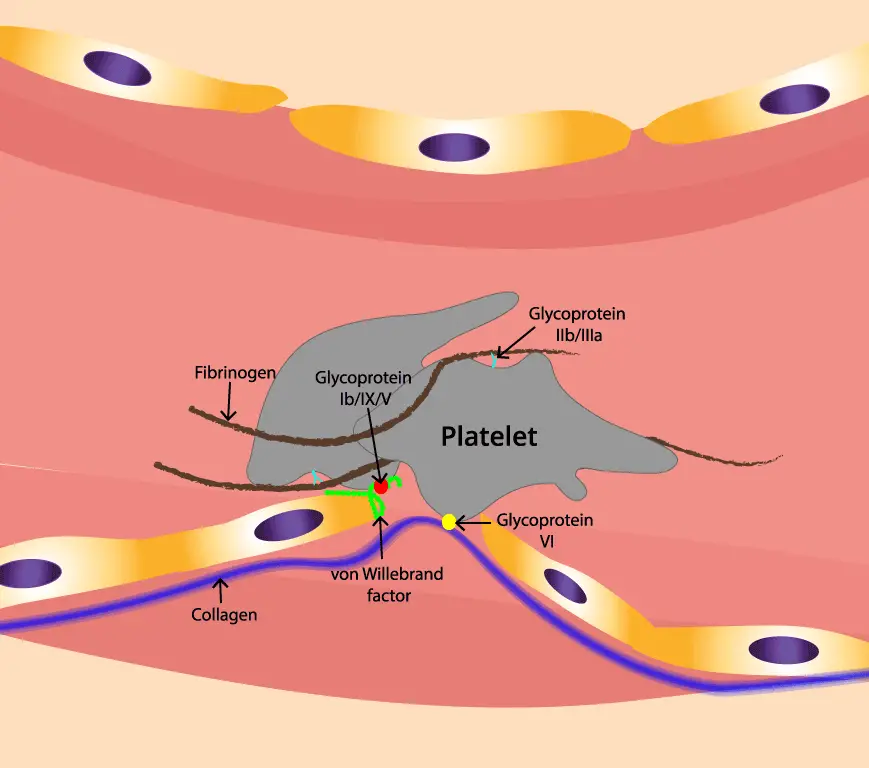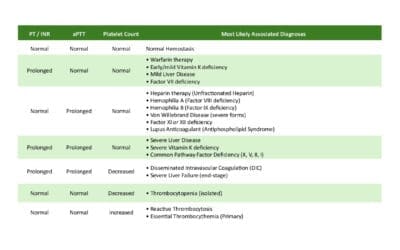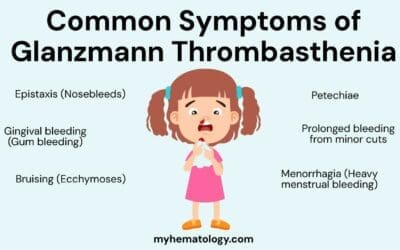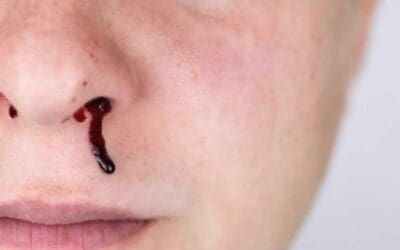TL;DR
Von Willebrand disease or disorder is an inherited coagulation disorder caused by mutations in the von Willebrand factor (vWF). vWF is a factor VIII carrier protein and mediates platelet adhesion to endothelium
Pathogenesis ▾
- Quantitative deficiency
- Type 1: partial deficiency. Autosomal dominant, mild disorder, most common.
- Type 3: complete deficiency. Autosomal recessive, severe disorder.
- Qualitative defects
- Type 2: functional abnormalities.
- Subtypes: 2A, 2B, 2M, 2N
Signs and symptoms ▾
- Excessive bleeding from cuts, injuries, surgery, dental procedures, and menstruation
- Frequent nosebleeds
- Heavy or long menstrual periods
- Heavy bleeding during labor and delivery
- Blood in the urine or stool
- Easy bruising
- Lumpy bruises
Laboratory diagnosis ▾
- Increased: APTT, bleeding time
- Normal: PT, platelet count
- Decrease: vWF assay, platelet function test, aggregation with ristocetin
Treatment and management ▾
- DDAVP in mild bleeding
- Intermediary purity factor VIII concentrates
- Fibrinolytic inhibitors
*Click ▾ for more information
What is von Willebrand disorder (vWD)?
von Willebrand disorder (vWD) is the most common inherited bleeding disorder, caused by a deficiency or abnormality of von Willebrand factor (vWF) resulting from a point mutation or major deletion.

What is von Willebrand factor (vWF)?
Von Willebrand factor (vWF) is a large glycoprotein that plays a vital role in hemostasis, the process by which blood clots to stop bleeding. It is encoded by the vWF gene, which is located on chromosome 12. The vWF gene is approximately 178 kilobase pairs long and contains 52 exons. vWF is synthesized as a large 300 kDa protein which then forms mutimers up to 106 in weight.
vWF is produced by endothelial cells (the cells that line the inside of blood vessels) and megakaryocytes (the cells in the bone marrow that give rise to platelets). vWF is secreted into the blood plasma, where it circulates as a multimeric protein of varying sizes. The largest vWF multimers are the most active and have the greatest ability to bind to platelets.
vWF has two main functions in hemostasis:
- Platelet adhesion: vWF helps platelets to adhere to each other and to the damaged blood vessel wall. This is the first step in the formation of a blood clot.
- Factor VIII stabilization: vWF binds to factor VIII, another important clotting factor, and protects it from degradation. Factor VIII is essential for the formation of thrombin, the enzyme that converts fibrinogen to fibrin, the main component of a blood clot.
Mutations in the vWF gene can cause von Willebrand disorder (vWD), a bleeding disorder that is characterized by easy bruising, nosebleeds, and heavy menstrual periods. The severity of vWD varies depending on the type and severity of the mutation.

von Willebrand disorder (vWD) types
Three von Willebrand disorder (vWD) types have been described. Types 1 and 3 are caused by vWF protein deficiency, as measured by vWF antigen levels. Type 1 is by far the most common form, accounting for over 70% of affected individuals. It is inherited in an autosomal dominant manner with varying expressions of 15% – 60%. The severity of the bleeding is variable. Typically, there is mucous membrane bleeding, excessive blood loss from superficial cuts and abrasions and operative and post-traumatic hemorrhage.
In contrast to type 1 disease, levels of vWF antigen are less than 5% of normal in type 3 von Willebrand disorder (vWD) and the inheritance pattern is autosomal recessive. Due to the fact that levels of vWF protein are so low in type 3 patients, they have much more severe bleeding and may develop hemarthrosis and other deep tissue bleeding similar to hemophilia A patients.
Type 2 disease is inherited in the same autosomal dominant manner as type 1. It accounts for about 25% of von Willebrand disorder (vWD). In these patients, the vWF antigen and factor VIII levels are generally normal but the vWF protein is qualitatively abnormal, leading to low ristocetin cofactor activity. Type 2 disease includes several subtypes.
Most individuals with type 2A disease have defective multimerization of vWF protein thus they bleed because of failure to form large multimers which greatly impairs the ability of vWF to tether platelets to injured endothelium. In type 2B, there is also reduction in the very large multimers but due to structural mutations that increase the binding of vWF to platelet GPIb/IX. This results in clearance of large multimers from the plasma and sometimes causes mild thrombocytopenia. Type 2M is characterised by reduced binding of vWF to GPIb while in type 2N, patients inherit 2 defective copies of vWF with mutations within the N-terminal domain that abolish vWF binding to factor VIII. As a result, the vWF factor antigen and ristocetin cofactor levels are normal but the factor VIII are very low, and the patient has a clinical phenotype very similar to that of hemophilia A.
In summary,
- Type 1 is the most common type, and it is caused by a quantitative deficiency of vWF.
- Type 2 is caused by a qualitative abnormality of vWF. There are four subtypes of type 2 VWD, each with its own characteristic defect in vWF function.
- Type 3 is the rarest and most severe type, and it is caused by a complete absence of vWF.
How does von Willebrand disorder (vWD) cause bleeding?
The pathophysiology of von Willebrand disorder (vWD) varies depending on the type and severity of the disorder. However, all types of von Willebrand disorder (vWD) can lead to bleeding problems because of the deficiency or dysfunction of vWF.
In type 1, the low levels of vWF impair platelet adhesion and factor VIII stabilization. This can lead to bleeding from cuts, injuries, surgery, dental work, and childbirth.
In type 2, the qualitative defects in vWF can impair platelet adhesion and factor VIII stabilization in different ways. Some people with type 2 may have bleeding problems similar to those with type 1, while others may have more severe bleeding problems.
In type 3, the complete or nearly complete deficiency of vWF leads to severe bleeding problems from even minor cuts and injuries. People with type 3 may also experience spontaneous bleeding, such as bleeding into the joints or internal organs.
The severity of bleeding problems in von Willebrand disorder (vWD) also depends on the level of factor VIII. People with von Willebrand disorder (vWD) often have low levels of factor VIII because vWF helps to stabilize factor VIII in the blood. Low levels of factor VIII can make the bleeding problems in von Willebrand disorder (vWD) worse.
In addition to the bleeding problems, von Willebrand disorder (vWD) can also lead to other complications, such as:
- Iron deficiency anemia: This can occur from chronic blood loss.
- Arthritis: This can occur from repeated bleeding into the joints.
- Pregnancy complications: Women with von Willebrand disorder (vWD) may have an increased risk of heavy bleeding during childbirth and miscarriage.
Clinical signs and symptoms of von Willebrand disorder (vWD)
The clinical manifestations of von Willebrand disorder (vWD) vary depending on the type and severity of the disorder. Some people with von Willebrand disorder (vWD) have mild or no symptoms, while others have heavy and prolonged bleeding. However, all types of von Willebrand disorder (vWD) can lead to bleeding problems.
The most common clinical manifestations of von Willebrand disorder (vWD) include:
- Easy bruising, even from minor bumps or knocks.
- Nosebleeds: Frequent or long-lasting nosebleeds.
- Heavy menstrual periods: Women with von Willebrand disorder (vWD) may have heavy menstrual periods, with bleeding that lasts longer than 7 days or requires more than one pad or tampon per hour.
- Bleeding after surgery or dental work: People with von Willebrand disorder (vWD) may experience excessive bleeding after surgery or dental work.
- Bleeding into the joints or internal organs: People with severe von Willebrand disorder (vWD) may experience spontaneous bleeding, such as bleeding into the joints or internal organs.
- Heavy bleeding during labor and delivery
- Blood in the urine or stool
How is von Willebrand disorder (vWD) diagnosed?
von Willebrand disorder (vWD) can be difficult to diagnose because the bleeding problems can vary in severity and can be similar to other bleeding disorders. However, there are a number of tests that can be used to diagnose von Willebrand disorder (vWD).
The first step in diagnosing von Willebrand disorder (vWD) is to take a medical history and perform a physical examination. Medical history must include symptoms, when they started, how often they occur, how severe they are and patient’s family history of bleeding disorders. Physical examination include signs of bleeding, such as bruises, nosebleeds, and heavy menstrual periods .
Laboratory investigations include:
- Complete blood count (CBC): This test measures the number of red blood cells, white blood cells, and platelets in the blood. Platelet count is normal in this disease except for type 2B where it is low.
- Prothrombin time (PT): This test measures how long it takes for the blood to clot. PT is normal in vWD.
- Activated partial thromboplastin time (aPTT): This test measures how long it takes for the blood to clot in the presence of certain clotting factors. A prolonged APTT may be a sign of a bleeding disorder, such as von Willebrand disorder (vWD).
- Von Willebrand factor antigen (VWF:Ag): This test measures the amount of vWF in the blood. A low VWF:Ag level may be a sign of VWD.
- Von Willebrand factor activity (VWF:RCo): A functional assay of plasma vWF based upon the degree of platelet agglutination induced after the addition of Ristocetin. This test measures how well vWF is working. A low VWF:RCo level may be a sign of von Willebrand disorder (vWD).
Additional tests:
- vWF multimer analysis: This test measures the size and distribution of vWF multimers in the blood. vWF multimers may be abnormal in von Willebrand disorder (vWD).
- Factor VIII activity: This test measures the amount of factor VIII in the blood. Factor VIII is another important clotting factor that is stabilized by vWF. Low levels of factor VIII may be see in von Willebrand disorder (vWD).
- Genetic testing: A positive mutation identification can confirm von Willebrand disorder (vWD).
How is von Willebrand disorder (VWD) treated?
The goal of treatment for von Willebrand disorder (vWD) is to prevent or control bleeding episodes. Treatment depends on the type and severity of von Willebrand disorder (vWD), as well as the individual patient’s needs.
von Willebrand disorder (vWD) treatment include:
- Desmopressin: Desmopressin is a medication that stimulates the release of vWF from the body’s stores like endothelial cells by acting on the V2 receptor. It is available as a nasal spray or an injection. Desmopressin is often used to treat mild to moderate von Willebrand disorder (vWD) and to prevent bleeding before surgery or dental work. However, desmopressin is contraindicated in type 2B von Willebrand disorder (vWD) because it induces severe thrombocytopenia.
- Von Willebrand factor (vWF) concentrate: Von Willebrand factor (vWF) concentrate is a blood product that contains vWF. It is administered intravenously (into a vein). Von Willebrand factor (vWF) concentrate is used to treat severe von Willebrand disorder (vWD) and to prevent or control bleeding episodes in people with mild to moderate von Willebrand disorder (vWD) who do not respond to desmopressin.
- Clot-stabilizing medications (fibrinolytic inhibitors): Clot-stabilizing medications, such as aminocaproic acid and tranexamic acid, can help to prevent blood clots from breaking down. These medications are often used to prevent bleeding in people with VWD who are undergoing surgery or dental work.
- Birth control pills: Birth control pills can help to control heavy menstrual periods in women with von Willebrand disorder (vWD) as it can increase the amount of vWF and factor VIII in the blood and decrease menstrual blood loss.
In addition to medication, there are a number of lifestyle changes that can help people with von Willebrand disorder (vWD) manage their condition. These lifestyle changes include:
- Avoiding activities that could lead to bleeding for example contact sports
- Taking care of their teeth and gums: People with von Willebrand disorder (vWD) should brush and floss their teeth regularly and see a dentist for regular checkups and cleanings.
- Getting regular exercise: Exercise can help to improve blood circulation and reduce the risk of bleeding.
- Eating a healthy diet: Eating a healthy diet can help to maintain a healthy weight and improve overall health.
- Avoid taking blood thinners like aspirin.
People with von Willebrand disorder (vWD) should work with their doctor to develop a treatment plan that is right for them. With proper treatment, most people with von Willebrand disorder (vWD) can live full and active lives.
Here are some additional tips for managing von Willebrand disorder (vWD):
- Wear a medical alert bracelet or necklace: This will let medical professionals know that you have VWD in case of an emergency.
- Carry a copy of your medical records with you: This should include your diagnosis, treatment plan, and contact information for your doctor.
- Educate yourself and your loved ones about VWD: This will help you to understand your condition and how to manage it.
- Join a support group: There are a number of support groups available for people with VWD and their families. These groups can provide emotional support and practical advice.
With proper management, most people with VWD can live long and healthy lives.
Frequently Asked Questions (FAQs)
What is the life expectancy of someone with von Willebrand disease?
People with von Willebrand disorder (vWD) generally have a normal life expectancy, especially those with the most common and mild form, type 1. This is because von Willebrand disorder (vWD) is a manageable bleeding disorder, and with proper treatment, people with von Willebrand disorder (vWD) can live long and healthy lives.
However, it’s important to note that there are different types of von Willebrand disorder (vWD), and the severity of symptoms can vary. In rare cases, people with severe VWD may experience life-threatening bleeding episodes.
Is von Willebrand disorder (vWD) painful?
von Willebrand disorder (vWD) itself doesn’t directly cause pain, but it can lead to symptoms that can be painful, such as:
- Bleeding into joints and muscles: This is a less common symptom but can occur in some people with von Willebrand disorder (vWD), especially those with the more severe type 3. This bleeding can cause swelling, stiffness, and pain in the affected joint or muscle.
- Heavy menstrual periods: This can be a significant issue for some women with von Willebrand disorder (vWD) and can cause pain and discomfort.
Is von Willebrand disorder (vWD) life threatening?
In most cases,von Willebrand disorder (vWD) is not life-threatening. The most common type, type 1 von Willebrand disorder (vWD), is usually mild and doesn’t cause life-threatening bleeding. Even with other types, proper management through treatment significantly reduces the risk.
However, it’s important to understand that:
- Uncontrolled bleeding can be life-threatening: While rare, severe bleeding episodes in any person, regardless of von Willebrand disorder (vWD), can become life-threatening if not addressed promptly.
- Severity of von Willebrand disorder (vWD) matters: People with severe forms of von Willebrand disorder (vWD) (types 2 and 3) are more prone to experiencing heavy, prolonged, or internal bleeding that can be life-threatening if left untreated.
- Certain situations increase risk: Situations like surgery, childbirth, or major injuries can increase the risk of life-threatening bleeding in individuals with von Willebrand disorder (vWD), even those with mild forms.
Can people with von Willebrand disorder (vWD) have babies?
Yes, women with von Willebrand disorder (vWD) can have healthy pregnancies and births. However, due to the potential for bleeding complications, pre-conceptional counseling and close monitoring throughout pregnancy are essential.
- von Willebrand disorder (vWD) Types and Pregnancy Risk
- Type 1: Most common and mildest form. vWF levels often increase during pregnancy, minimizing bleeding risk.
- Type 2: More severe bleeding symptoms. vWF levels may not rise significantly, requiring closer monitoring and potential treatment adjustments.
- Type 3: Rarest and most severe. vWF levels remain low, and factor replacement therapy is likely necessary throughout pregnancy.
- Increased Bleeding Risks During Pregnancy
- Vaginal bleeding: More common in the third trimester, especially with type 3 von Willebrand disorder (vWD).
- Postpartum hemorrhage (PPH): Increased risk for all von Willebrand disorder (vWD) types due to physiological changes after delivery.
- Management Strategies
- Pre-pregnancy counseling: Discussing von Willebrand disorder (vWD) severity, potential risks, and individualized management plans with a hematologist familiar with von Willebrand disorder (vWD) and obstetrics.
- vWF level monitoring: Regular monitoring of vWF activity throughout pregnancy to assess potential need for factor replacement therapy.
- Delivery planning: Minimizing invasive procedures (forceps, vacuum) and considering prophylactic factor replacement therapy around delivery, especially for types 2 & 3.
- Multidisciplinary team approach: Collaboration between hematologist, obstetrician, and potentially anesthesiologist for optimal care.
- Fetal Considerations
- Risk of inheriting von Willebrand disorder (vWD): Offspring have a 50% chance of inheriting the condition, but genetic counseling can provide further information.
Can von Willebrand disorder (vWD) affect the baby?
Yes, von Willebrand disorder (vWD) can potentially affect a baby in a few ways, but the risk depends on the severity of the mother’s von Willebrand disorder (vWD) and the specific type.
Risk of inheriting von Willebrand disorder (vWD)
- Babies born to a parent with von Willebrand disorder (vWD) have a 50% chance of inheriting the condition. However, the severity of the inherited von Willebrand disorder (vWD) can vary.
Bleeding complications during pregnancy
- Mothers with von Willebrand disorder (vWD), particularly those with severe types (2 & 3), have a higher risk of excessive bleeding during pregnancy, delivery, and postpartum. This can potentially lead to complications like:
- Anemia: If blood loss is significant, the mother might develop iron deficiency anemia, which can affect the baby’s growth and development.
- Premature birth or low birth weight: In severe cases, excessive blood loss can compromise blood flow to the baby, potentially leading to these complications.
What not to do with von Willebrand disorder (vWD)?
Medications
- Nonsteroidal anti-inflammatory drugs (NSAIDs) like ibuprofen and aspirin: These medications can further inhibit platelet function and worsen bleeding tendencies in VWD patients. Consider alternative pain relievers like acetaminophen.
- Antiplatelet medications: Drugs like clopidogrel (Plavix) and ticagrelor (Brilinta) are typically contraindicated due to their additional inhibition of platelet function, which can exacerbate bleeding in VWD.
Procedures
- Unnecessary invasive procedures: Practices like unnecessary biopsies, venipunctures, or intramuscular injections can increase bleeding risk. Explore alternative non-invasive options whenever possible.
- Uncontrolled blood pressure: Elevated blood pressure can put additional stress on already weakened blood vessels in VWD patients, potentially increasing bleeding risk. Ensure proper blood pressure management.
Activities
- High-contact sports and activities: Activities with a high risk of falls or injuries, like contact sports (rugby, football), should be approached with caution and discussed individually with the patient. Alternative lower-risk activities might be encouraged.
Other
- Smoking and alcohol: These habits can negatively impact overall health and potentially worsen bleeding tendencies. Encourage smoking cessation and moderate alcohol consumption.
- Ignoring warning signs: Educate patients to recognize and report any unusual bleeding symptoms promptly, such as prolonged nosebleeds, excessive menstrual bleeding, or bleeding into joints or muscles.
Can I donate blood if I have von Willebrand disorder (vWD)?
Generally, people with von Willebrand disorder (vWD) are not recommended to donate blood. This is due to a few key reasons:
- Risk of bleeding complications: Individuals with von Willebrand disorder (vWD) already have a tendency to bleed due to a deficiency or malfunction of the von Willebrand factor, a protein crucial for blood clot formation. Donating blood further reduces their blood volume and potentially exacerbates this bleeding risk.
- Donor safety: The blood donation process itself involves needle punctures, which can increase the risk of bleeding at the puncture site for individuals with von Willebrand disorder (vWD).
- Blood product quality: Because of the potential presence of low levels of von Willebrand factor (vWF) in the donated blood, it might not be suitable for all transfusion recipients, especially those who also have bleeding disorders.
Does von Willebrand disorder (vWD) worsen with age?
von Willebrand disorder (vWD) itself doesn’t necessarily worsen with age. vWF levels may increase with age in some, particularly those with type 1, but this doesn’t always translate to reduced bleeding risk. Individuals with severe forms (types 2 & 3) are unlikely to experience significant improvement in symptoms with age.
Does von Willebrand disorder (vWD) make you tired?
von Willebrand disorder (vWD) itself doesn’t directly cause fatigue. However, it can lead to situations that can contribute to fatigue in some individuals, such as:
- Iron deficiency anemia: This is a common complication of heavy menstrual bleeding, especially in women with von Willebrand disorder (vWD). Iron deficiency can lead to symptoms like fatigue, weakness, shortness of breath, and pale skin.
- Frequent bleeding episodes: Even if not severe, repeated bleeding episodes can lead to iron loss and contribute to fatigue, especially if iron stores are not adequately replenished.
- Pain: von Willebrand disorder (vWD) can sometimes cause painful symptoms like bleeding into joints and muscles, which can disrupt sleep and contribute to fatigue.
- Psychological stress: The burden of managing a chronic condition like von Willebrand disorder (vWD), including potential anxieties about bleeding episodes or limitations in activities, can contribute to psychological stress and potentially lead to fatigue.
At what age is von Willebrand disorder (vWD) diagnosed?
- Men: Studies suggest an average diagnosis age of around 30-40 years.
- Women: Due to menstrual bleeding being a common symptom, women are diagnosed earlier, on average between 12 and 50 years old.
- Children: While less common, von Willebrand disorder (vWD) can be diagnosed in children as well, especially if they experience frequent nosebleeds, prolonged bleeding from cuts, or excessive bleeding after procedures like tooth extraction.
Overall, there’s no single definitive age for VWD diagnosis.
Is it harder to get pregnant with von Willebrand disorder (vWD)?
No, von Willebrand disorder (vWD) itself doesn’t necessarily make it harder to get pregnant. In fact, many women with von Willebrand disorder (vWD) have successful pregnancies. However, there are some factors to consider:
- von Willebrand disorder (vWD) type:
- Type 1 (most common): Fertility is usually not affected. vWF levels may even increase during pregnancy, further reducing bleeding risk.
- Type 2 & 3 (more severe): While conception is possible, there might be a higher risk of miscarriage or bleeding complications due to lower vWF levels.
- Hormonal therapy: Medications used to regulate heavy menstrual bleeding, a common symptom in some women with von Willebrand disorder (vWD), can interfere with ovulation and make conception more challenging.
Can you have von Willebrand disorder (vWD) if your parents don’t?
While von Willebrand disorder (vWD) is typically inherited from parents, it’s possible to have it even if your parents don’t, due to a phenomenon called sporadic mutations. In rare cases, von Willebrand disorder (vWD) can occur due to a spontaneous genetic mutation in the egg or sperm cell, not inherited from either parent. This is known as a de novo mutation. These mutations can happen during cell division and are not present in the parents’ genes. Such sporadic mutations account for approximately 10-30% of von Willebrand disorder (vWD) cases.
Is von Willebrand disorder (vWD) curable?
No, there is currently no cure for von Willebrand disorder (vWD). However, it is a treatable and manageable condition.
Disclaimer: This article is intended for informational purposes only and is specifically targeted towards medical students. It is not intended to be a substitute for informed professional medical advice, diagnosis, or treatment. While the information presented here is derived from credible medical sources and is believed to be accurate and up-to-date, it is not guaranteed to be complete or error-free. See additional information.
References
- Saba HI, Roberts HR. Hemostasis and Thrombosis: Practical Guidelines in Clinical Management (Wiley Blackwell). 2014.
- DeLoughery TG. Hemostasis and Thrombosis 4th Edition (Springer). 2019.
- Keohane EM, Otto CN, Walenga JM. Rodak’s Hematology 6th Edition (Saunders). 2019.
- Kaushansky K, Levi M. Williams Hematology Hemostasis and Thrombosis (McGraw-Hill). 2017.
- Yawn BP, Nichols WL, Rick ME. Diagnosis and Management of Von Willebrand Disease: Guidelines for Primary Care. Am Fam Physician. 2009;80(11):1261-1268.



